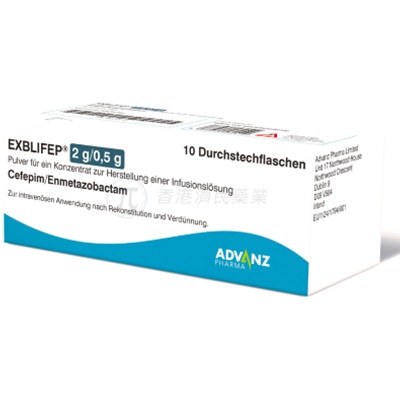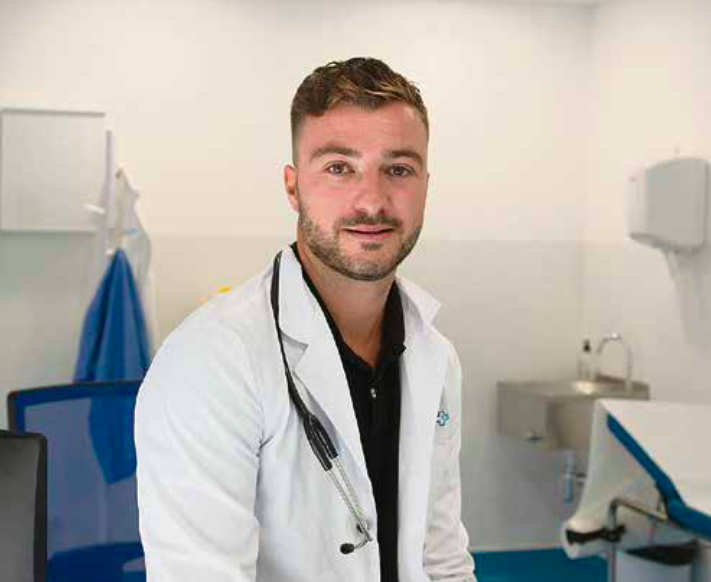

EXBLIFEP 2 G/0.5 G POWDER FOR CONCENTRATE FOR SOLUTION FOR INFUSION

Ask a doctor about a prescription for EXBLIFEP 2 G/0.5 G POWDER FOR CONCENTRATE FOR SOLUTION FOR INFUSION

How to use EXBLIFEP 2 G/0.5 G POWDER FOR CONCENTRATE FOR SOLUTION FOR INFUSION
Introduction
Package Leaflet: Information for the Patient
EXBLIFEP 2 g/0.5 g powder for concentrate for solution for infusion
cefepime/enmetazobactam
This medicinal product is subject to additional monitoring, which will allow for the quick identification of new safety information. You can help by reporting any side effects you may have. The last section of section 4 will tell you how to report side effects.
Read all of this leaflet carefully before you start using this medicine because it contains important information for you.
- Keep this leaflet, you may need to read it again.
- If you have any further questions, ask your doctor or pharmacist.
- If you get any side effects, talk to your doctor or pharmacist. This includes any possible side effects not listed in this leaflet. See section 4.
Contents of the pack
- What is EXBLIFEP and what is it used for
- What you need to know before you use EXBLIFEP
- How to use EXBLIFEP
- Possible side effects
- Storage of EXBLIFEP
- Contents of the pack and other information
1. What is EXBLIFEP and what is it used for
EXBLIFEP is an antibiotic that contains two active substances:
- cefepime, which belongs to a group of antibiotics called fourth-generation cephalosporins and can destroy certain bacteria;
- enmetazobactam, which blocks the action of certain enzymes called beta-lactamases. These enzymes make bacteria resistant to cefepime by breaking down the antibiotic before it can take effect. By blocking the action of beta-lactamases, enmetazobactam makes cefepime more effective in destroying bacteria.
EXBLIFEP is used in adults for the treatment of:
- complicated urinary tract infections (bladder and kidneys)
- certain types of pneumonia (lung infection) that occur during hospitalization
EXBLIFEP is also used to treat bacteremia (presence of bacteria in the blood) due to or possibly due to one of the infections listed above.
2. What you need to know before you use EXBLIFEP
Do not use EXBLIFEP:
- if you are allergic to cefepime, enmetazobactam, or any of the other ingredients of this medicine (listed in section 6).
- if you are allergic to cephalosporins, which are antibiotics used to treat a wide range of infections.
- if you have had a severe allergic reaction (e.g., severe skin peeling, swelling of the face, hands, feet, lips, tongue, or throat, or difficulty swallowing or breathing) to beta-lactam antibiotics (such as penicillins, carbapenems, or monobactams).
Warnings and precautions
Talk to your doctor or pharmacist beforeyou start using EXBLIFEP if:
- you are allergic to cephalosporins, penicillins, or other antibiotics (see "Do not use EXBLIFEP").
- you have or have had asthma or are prone to allergic reactions. The first time you are given this medicine, your doctor will monitor you for signs of an allergic reaction (see section 4).
- you have kidney problems. Your doctor may need to change the dose of this medicine.
- you are going to have a blood or urine test. This medicine may affect the results of some tests (see section 4).
Talk to your doctor or pharmacist whileyou are using EXBLIFEP if:
- you have severe and persistent diarrhea during or just after treatment. It could be a sign of inflammation of the large intestine and requires urgent medical attention.
- you suspect that you have acquired an infection during prolonged use of EXBLIFEP. It could be due to microorganisms that are not sensitive to cefepime and may require discontinuation of EXBLIFEP treatment.
Children and adolescents
This medicine should not be given to children under 18 years of age because there is not enough information on its use in this age group.
Other medicines and EXBLIFEP
Tell your doctor or pharmacist if you are using, have recently used, or might use any other medicines.
In particular, tell your doctor if you are using any of the following medicines:
- other antibiotics, especially aminoglycosides (such as gentamicin) or diuretics (such as furosemide). If you are using these medicines, your kidney function should be monitored.
- medicines used to prevent blood clotting (cumarinic anticoagulants, such as warfarin). Their effect may be increased if you use EXBLIFEP.
- certain types of antibiotics (bacteriostatic antibiotics). These antibiotics may affect the functioning of EXBLIFEP.
Pregnancy and breastfeeding
If you are pregnant or breastfeeding, think you may be pregnant, or are planning to have a baby, ask your doctor for advice before using this medicine.
Your doctor will decide whether you can use EXBLIFEP during pregnancy.
EXBLIFEP may be excreted in breast milk. If you are breastfeeding, your doctor will decide whether you should stop breastfeeding or not use EXBLIFEP treatment, taking into account the benefit of breastfeeding for your child and the benefit of treatment for you.
Driving and using machines
This medicine may cause dizziness, which may affect your ability to drive or use machines. Do not drive or use machines until this effect has disappeared.
3. How to use EXBLIFEP
Your doctor or another healthcare professional will give you this medicine through an infusion (drip) into a vein (directly into the bloodstream). Depending on the type of infection you have and your kidney function, the infusion will be given over 2 or 4 hours.
The recommended dose is one vial (2 g of cefepime and 0.5 g of enmetazobactam) every 8 hours.
Treatment usually lasts between 7 and 14 days, depending on the severity, location, and response of your body to treatment.
If you have kidney problems, your doctor may need to reduce the dose or change the frequency of administration of EXBLIFEP (see section 2. Warnings and precautions).
If you use more EXBLIFEP than you should
Since this medicine will be given to you by a doctor or another healthcare professional, it is unlikely that you will be given too much EXBLIFEP. However, if you have any doubts or concerns, talk to your doctor, nurse, or pharmacist.
If you forget to use EXBLIFEP
If you think you have missed a dose of EXBLIFEP, tell your doctor or another healthcare professional immediately.
If you have any other questions about the use of this medicine, ask your doctor or pharmacist.
4. Possible side effects
Like all medicines, this medicine can cause side effects, although not everybody gets them.
Tell your doctor immediately if you experience any of the following side effects because you may need urgent medical treatment:
Rare: may affect up to 1 in 1,000 people
- anaphylactic reaction (allergic) and angioedema. This reaction can be life-threatening.
Symptoms and signs may include sudden swelling of the lips, face, throat, or tongue, a severe rash, and difficulty swallowing or breathing.
Frequency not known: frequency cannot be estimated from the available data
- Stevens-Johnson syndrome and toxic epidermal necrolysis. Severe and intense skin reactions. The adverse skin reaction may appear as a rash, with or without blisters. Skin irritation, ulcers, or inflammation in the mouth, throat, eyes, nose, and genital areas, as well as fever and flu-like symptoms, may occur. Skin rashes can become severe skin lesions (peeling of the epidermis and superficial mucous membranes) that can have potentially fatal consequences.
Other side effects
Other side effects that may occur after EXBLIFEP treatment include:
Very common: may affect more than 1 in 10 people
Side effects identified through blood tests:
- positive Coombs test (a blood test to check for antibodies that attack red blood cells produced by the body itself)
Common: may affect up to 1 in 10 people
- phlebitis at the infusion site (inflammation at the infusion site that causes pain, swelling, and redness along a vein)
- reaction, pain, and inflammation at the infusion site
- diarrhea
- skin rash
- headache
Side effects identified through blood tests:
- increased liver enzyme levels in the blood
- increased bilirubin levels (a substance produced by the liver) in the blood
- increased amylase levels (an enzyme that helps the body digest carbohydrates) in the blood
- increased lipase levels (an enzyme that helps the body digest fats) in the blood
- increased lactate dehydrogenase levels (a marker that indicates cellular and tissue damage in the body) in the blood
- changes in white blood cell counts (eosinophilia)
- low red blood cell counts (anemia)
- increased blood coagulation time (increased time for blood to clot)
Uncommon: may affect up to 1 in 100 people
- Clostridioides difficile-associated diarrhea (CDAD), a painful and severe diarrhea caused by a bacterium called Clostridioides difficile
- oral thrush
- vaginal infection
- inflammation of the large intestine that causes diarrhea, usually accompanied by blood and mucus
- dizziness, nausea, vomiting
- skin redness, hives, itching
- fever
- inflammation at the infusion site
Side effects identified through blood tests:
- low levels of certain blood cells (leucopenia, neutropenia, thrombocytopenia)
- increased urea and creatinine levels (parameters that indicate reduced kidney function) in the blood
Rare: may affect up to 1 in 1,000 people
- breathing difficulties
- stomach pain, constipation
- fungal infection
- seizures (epileptic fits)
- altered sense of taste
- tingling or numbness of the skin, muscle cramps
- itching around the vaginal area
- allergic dermatitis
- chills
- vasodilation (widening of blood vessels)
Frequency not known: frequency cannot be estimated from the available data
- coma
- reduced level of consciousness
- encephalopathy (a brain disorder caused by toxic substances or infection)
- altered state of consciousness
- muscle spasms
- confusion, hallucinations
- false-positive glucose test in urine
- kidney problems (failure or any other physiological change or dysfunction)
- bleeding
- erythema multiforme (a skin rash that can form blisters and appears as small targets (a central dark spot, surrounded by a lighter area, with a dark ring around the edge)
Side effects identified through blood tests:
- very low levels of granulocytes, a type of white blood cell (agranulocytosis)
- rapid breakdown of red blood cells (hemolytic anemia)
- low red blood cell counts due to the inability of the bone marrow to produce enough cells (aplastic anemia)
Reporting of side effects
If you experience any side effects, talk to your doctor or pharmacist, even if they are not listed in this leaflet. You can also report side effects directly through the national reporting system listed in Annex V. By reporting side effects, you can help provide more information on the safety of this medicine.
5. Storage of EXBLIFEP
Keep this medicine out of the sight and reach of children.
Do not use this medicine after the expiry date which is stated on the carton and vial after "EXP". The expiry date is the last day of the month stated.
Unopened vial: Store in a refrigerator (between 2°C and 8°C). Keep the vial in the outer packaging to protect it from light.
After reconstitution and dilution: Store in a refrigerator (between 2°C and 8°C) for a maximum of 6 hours before use.
From a microbiological point of view, the medicine should be used immediately after reconstitution.
Medicines should not be disposed of via wastewater or household waste. Ask your pharmacist how to dispose of medicines no longer required. This will help protect the environment.
6. Container Contents and Additional Information
Composition of EXBLIFEP
- The active ingredients are cefepime and enmetazobactam.
- Each vial contains cefepime dihydrochloride monohydrate, equivalent to 2 g of cefepime and 0.5 g of enmetazobactam.
- The other components are L-arginine.
Appearance of the Product and Container Contents
EXBLIFEP is a powder for concentrate for solution for infusion (powder for concentrate) of white to yellow color, contained in 20 ml glass vials, with a bromobutyl rubber stopper and a flip-off safety seal.
Container size of 10 vials.
Marketing Authorization Holder
Advanz Pharma Limited
Unit 17 Northwood House
Northwood Crescent
Dublin 9
D09 V504
Ireland
(+44) (0)208.588.9131
Manufacturer
Infosaúde - Instituto De Formação E Inovação Em Saúde S.A.
Rua Das Ferrarias Del Rei,
nº6 - Urbanização da Fábrica da Pólvora,
Barcarena,
2730-269,
Portugal
Date of the Last Revision of this Prospectus:
Other Sources of Information
Detailed information on this medicinal product is available on the European Medicines Agency website: http://www.ema.europa.eu.
---------------------------------------------------------------------------------------------------------------------------
This information is intended solely for healthcare professionals:
Preparation of the Solution
This medicinal product is for intravenous infusion, and each vial is for single use only.
To prepare the infusion solution, aseptic techniques must be followed.
Preparation of Doses
Cefepime/enmetazobactam is compatible with a 9 mg/ml sodium chloride injectable solution (0.9%), a 5% glucose injection solution, and a combination of glucose injection solution and sodium chloride injection solution (containing 2.5% glucose and 0.45% sodium chloride).
EXBLIFEP is supplied as a dry powder contained in a single-dose vial, which must be reconstituted and then diluted before intravenous infusion, as indicated below.
To prepare the necessary dose for intravenous infusion, reconstitute the vial as indicated in Table 1below:
- Withdraw 10 ml from a 250 ml infusion bag (compatible with the injectable solution) and reconstitute the cefepime/enmetazobactam vial.
- Mix gently to dissolve. The reconstituted cefepime/enmetazobactam solution will have an approximate cefepime concentration of 0.20 g/ml and an approximate enmetazobactam concentration of 0.05 g/ml. The final volume is approximately 10 ml.
PRECAUTION: THE RECONSTITUTED SOLUTION IS NOT INTENDED FOR DIRECT INJECTION.
Subsequently, the reconstituted solution must be diluted immediatelyin a 250 ml infusion bag (compatible with the injectable solution) before intravenous infusion. To dilute the reconstituted solution, withdraw all or part of the contents of the reconstituted vial and transfer it back to the infusion bag, according to Table 1below.
- The intravenous infusion of the diluted solution must be completed within 8 hours, if stored in the refrigerator (i.e., between 2°C and 8°C; when refrigerated for less than 6 hours, before allowing it to reach room temperature and then administering it at room temperature for a period of 2 or 4 hours).
Table 1. Preparation of Cefepime/Enmetazobactam Doses
Cefepime/Enmetazobactam Dose | Number of Vials to be Reconstituted | Volume to be Withdrawn from each Reconstituted Vial for Dilution | Final Volume of the Infusion Bag |
2.5 g (2 g/0.5 g) | 1 | Entire contents (approximately 10 ml) | 250 ml |
1.25 g (1 g/0.25 g) | 1 | 5.0 ml (discard unused contents) | 245 ml |
0.625 g (0.5 g/0.125 g) | 1 | 2.5 ml (discard unused contents) | 242.5 ml |
Examine the vial before use. It should only be used if the solution does not contain suspended particles. Use only clear solutions.
Like other cephalosporins, cefepime/enmetazobactam solutions may acquire a yellowish to amber color, depending on storage conditions. However, this does not negatively affect the product's effect.
The prepared solution should be administered by intravenous infusion.
Disposal of unused medicinal products and all materials that have come into contact with them should be carried out in accordance with local regulations.
- Country of registration
- Active substance
- Prescription requiredYes
- Manufacturer
- This information is for reference only and does not constitute medical advice. Always consult a licensed doctor before taking any medication. Oladoctor is not responsible for medical decisions based on this content.
- Alternatives to EXBLIFEP 2 G/0.5 G POWDER FOR CONCENTRATE FOR SOLUTION FOR INFUSIONDosage form: INJECTABLE, 1000 mgActive substance: cefepimeManufacturer: Fresenius Kabi España, S.A.U.Prescription requiredDosage form: INJECTABLE, 2000 mgActive substance: cefepimeManufacturer: Fresenius Kabi España, S.A.U.Prescription requiredDosage form: INJECTABLE, 1000 mgActive substance: cefepimeManufacturer: Ldp Laboratorios Torlan S.A.Prescription required
Online doctors for EXBLIFEP 2 G/0.5 G POWDER FOR CONCENTRATE FOR SOLUTION FOR INFUSION
Discuss dosage, side effects, interactions, contraindications, and prescription renewal for EXBLIFEP 2 G/0.5 G POWDER FOR CONCENTRATE FOR SOLUTION FOR INFUSION – subject to medical assessment and local rules.














